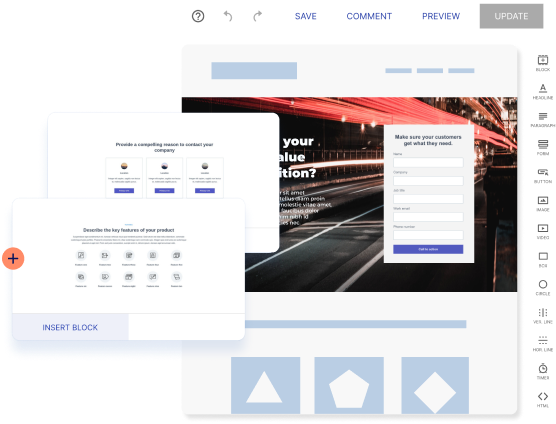With Google’s AI Overviews now live and LLM-powered tools like Perplexity and ChatGPT reshaping how people find answers, marketers are starting to panic. Visibility is shrinking, website traffic is dipping, and the old rules of search no longer feel reliable.
Many are rethinking their entire strategy because the playbook we’ve followed for the past two decades is changing quickly.
Is the SEO sky really falling? Is traditional Google search no longer relevant in the LLM age?
Yes, AI Overviews are gaining traction. And yes, more people now turn to ChatGPT and Perplexity to satisfy their queries.
According to the Semrush AI Overviews Study, 13.14% of all Google queries triggered an AI Overview in March 2025. That’s up from 6.49% in January.
Keywords that trigger Overviews also tend to have higher zero-click rates, though the study suggests this is likely due to informational intent, not the Overviews themselves.
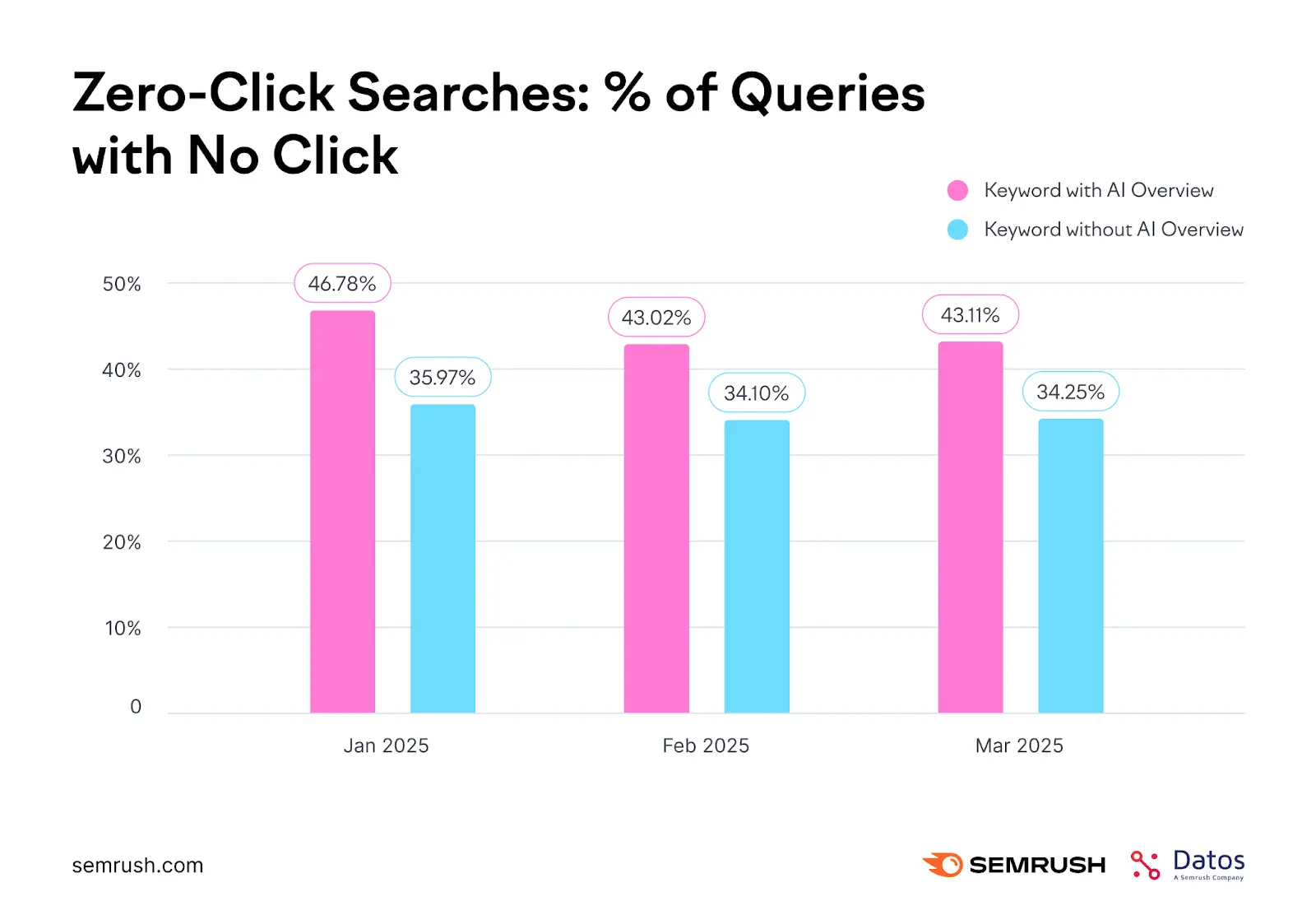
It sounds bleak. But there’s more to the story.
While these keywords do see above-average zero-click rates, that trend isn’t rising steadily. In fact, between January and March 2025, zero-click behavior on Overview-triggering queries declined slightly.
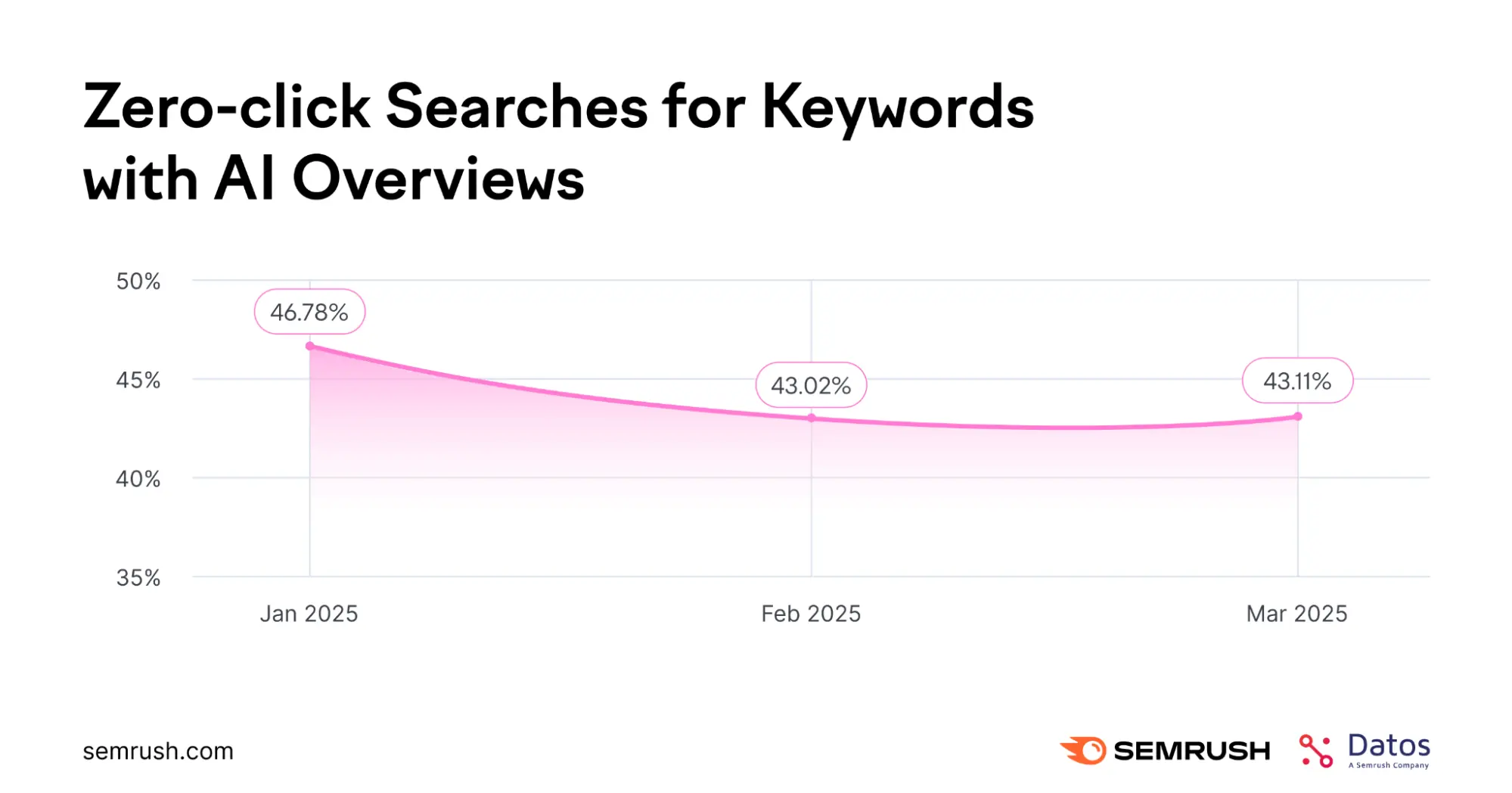
This challenges the idea that AI Overviews always reduce clicks, and points to a more complex relationship between query type, user intent, and how answers are presented.
Then there’s the broader search landscape.
The State of Search Q1 2025 report from Datos shows that Google’s average event share—the percentage of user interactions on a platform—was 9.42% in the U.S. and 9.89% in Europe between Q1 2024 and Q1 2025. In comparison, ChatGPT’s share was just 0.3% in both regions.
AI and LLM search engines are growing, but Google still holds the lion’s share of attention.
As Rand Fishkin, SparkToro Co-founder and CEO, puts it:
Yes, AI tools are popular, and yes, they’re growing. But despite the media hype, AI is still a tiny fraction of overall usage in the US, EU, and UK.
So no, the sky isn’t falling. But the map is changing.
The real question isn’t “Is Google search dead?”. It’s “How do we show up where attention is moving?”
Whether it’s AI Overviews or LLM-powered results from tools like ChatGPT and Perplexity, the visibility game is shifting. Smart marketers aren’t just watching, they’re adapting.
In this post, you’ll learn how to turn your website and landing pages into AI-visible assets. We’ll walk through how to format content, build trust signals, and structure your site for inclusion in both Google Overviews and LLM-generated answers—so you stay seen, clicked, and competitive.
8 strategies to show up in AI results, from AI mode, Perplexity, to ChatGPT
1. Optimize for both Google and LLMs, they’re interconnected but different
Your Google rankings still matter, more than ever before, in fact.
When Grow & Convert analyzed 400+ Keywords to see if Google SEO affected LLM optimization, they found that pages that rank in the top three of Google results are mentioned in ChatGPT 82% of the time and in Perplexity 77% of the time.
For example, when you Google “highly intuitive drag-and-drop builder for landing pages,” Instapage shows up as the #1 recommendation in AI Overviews.
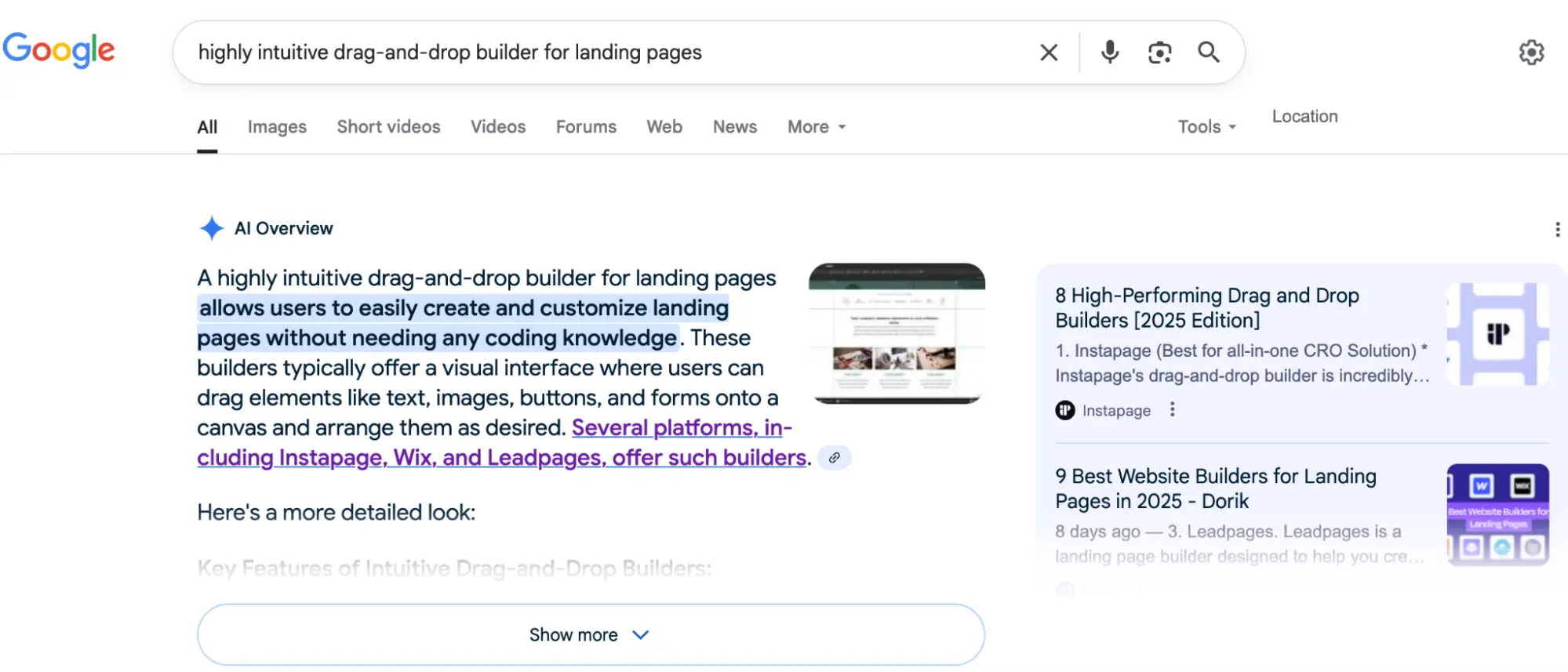
ChatGPT also suggests Instapage as the top pick for “drag and drop builders in 2025”.
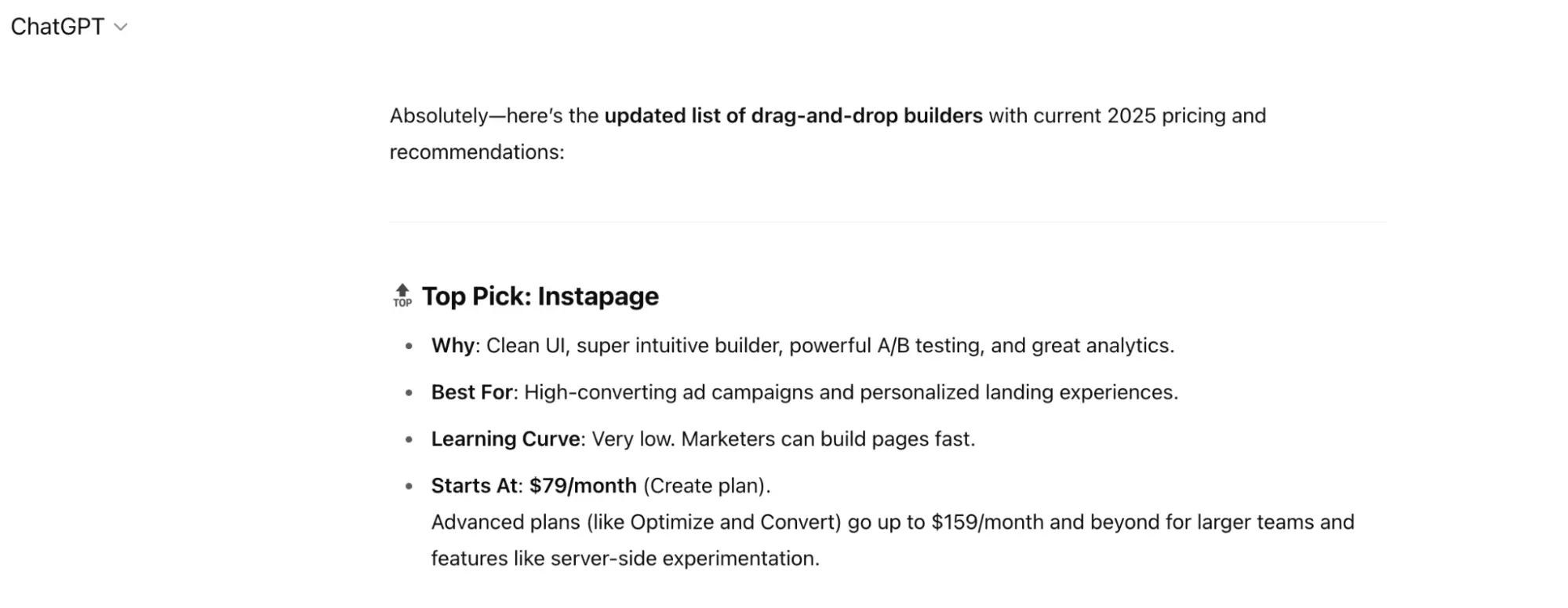
Instapage is also the top recommendation in Perplexity for a “highly intuitive drag-and-drop builder”.
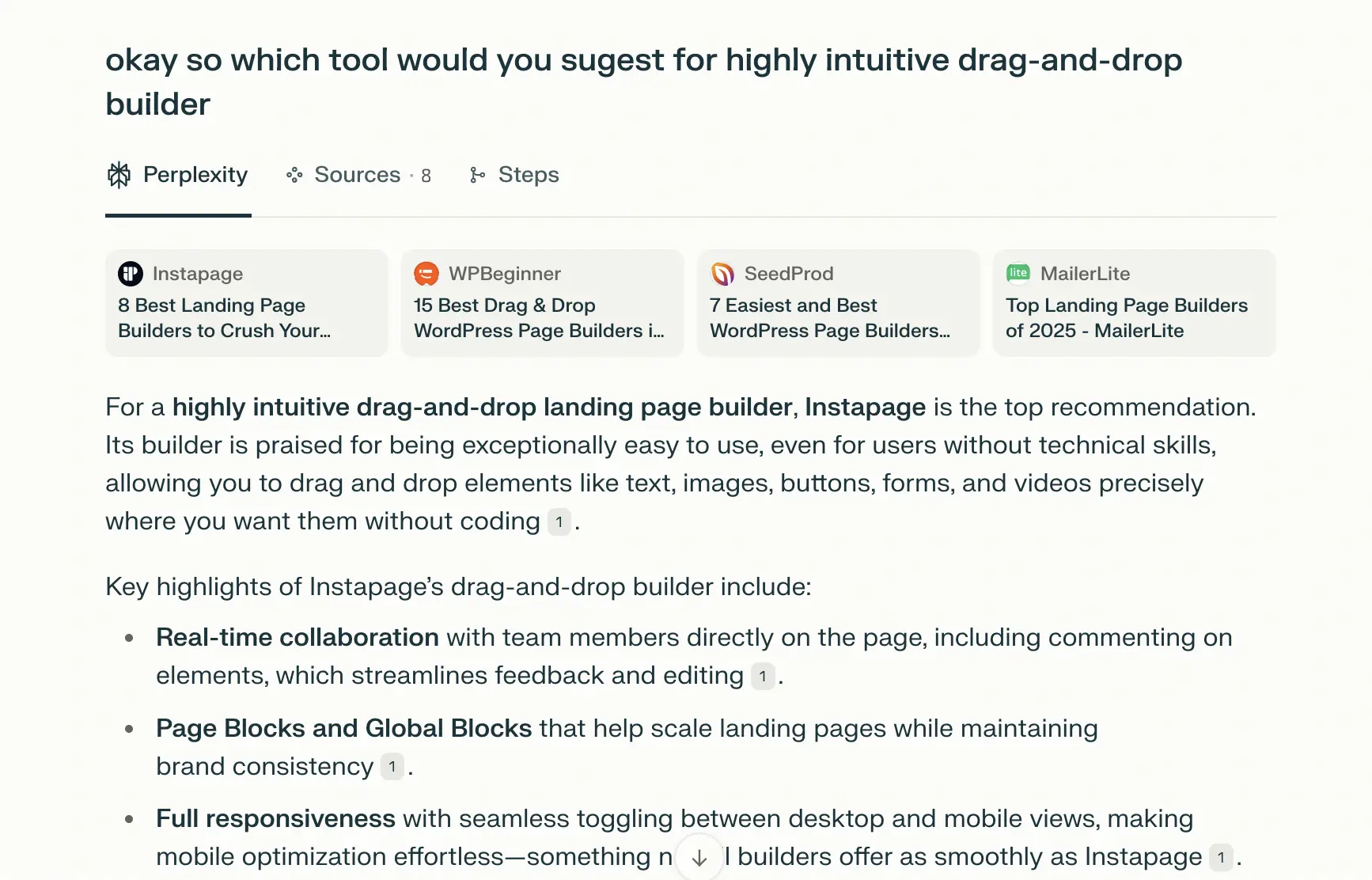
So if you’re trying to show up in AI-generated answers, don’t abandon traditional SEO. Instead, double down on core ranking factors like search intent alignment, keyword use, internal linking, and backlinks.
You can see how to configure your Instapage pages to appear on search engines and social platforms here.
That said, Google and LLMs aren’t identical. LLMs like ChatGPT and Claude care less about keywords and more about clarity, context, and whether your content includes precise, credible, well-explained answers. So, it’s best to take SEO and LLM visibility as a dual-layered strategy—ranking well helps you get noticed, but formatting and trust signals help you get chosen.
2. Write for the way AI thinks: analyze your structure, clarity, and Q&A formatting
To earn placement in AI Overviews and generative search results, you need to make your content easy to extract and summarize. This means your content needs to include:
- Clear and logical formatting
- Lead with direct answers to common questions
- Use subheadings that mirror natural language queries
- Present information using short paragraphs, numbered steps, and occasional lists where needed
Tools like ChatGPT often look for the same question formats users type in (“What is X?” “How do I…?”). Including these questions directly in your H2s and H3s increases the likelihood that your page will be interpreted as a reliable source.
You can use Instapage’s AI Content feature to instantly generate headlines, paragraphs, and CTAs based on simple prompts, right inside the builder, so you never have to start from scratch.
Schema markup (like FAQ Page and HowTo) can reinforce structure, but it’s the clarity of your writing and formatting that matters most.
This also applies to your landing pages. When your pages include structured H2 headings, direct benefit-driven language, and even FAQ sections, they’re more likely to be parsed and featured in AI Overviews and LLMs.
3. Build trust through credibility and entity recognition
AI systems look for content that demonstrates experience, expertise, authority, and trustworthiness. This means Google’s E-E-A-T framework is now more relevant than ever. Use real names and credentials for authors, cite data and reputable sources, and display clear topical authority in all your marketing materials.
Also, LLMs don’t just evaluate your content—they triangulate it against mentions elsewhere. If your brand or product shows up consistently in reviews, roundups, and external content, it gains credibility in the AI’s internal knowledge graph. Use your brand name and other key entities (like product lines, technologies, or spokespersons) clearly and consistently throughout your site.
This makes it easier for AI tools to recognize you as a known, trustworthy source worth citing.
4. Focus on content depth, not just keywords
Surface-level and top-of-the-funnel content rarely earns top spots in LLM search responses.
AI assistants are trained to prioritize comprehensive, informative answers. That means going beyond basic definitions and offering real insight: examples, comparisons, first-hand experience, and original perspectives.
For example, when you Google “why you should use Google ads,” you get results that share comprehensive reasons for what the platform offers marketers.
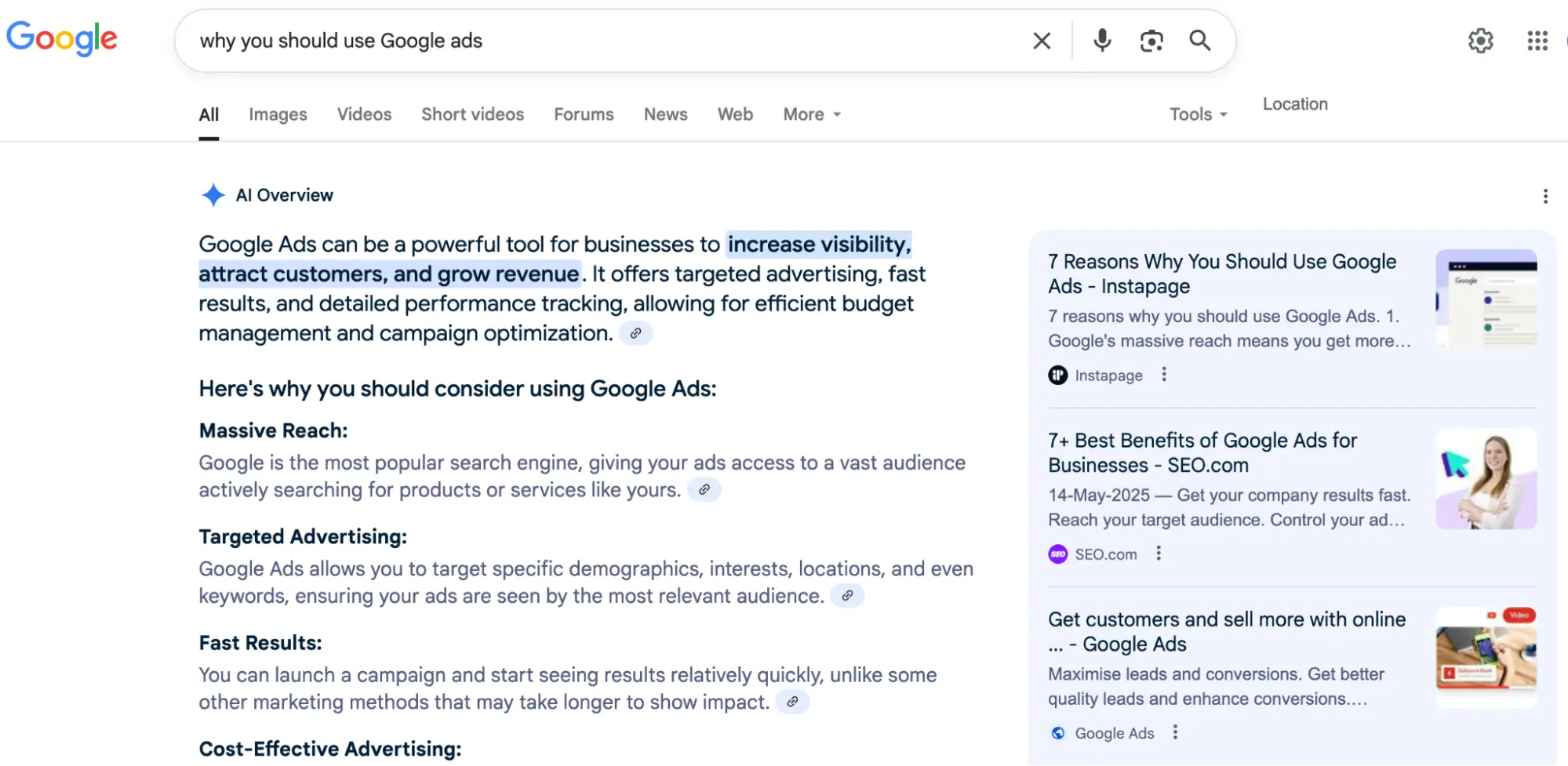
Content that demonstrates substance, not just SEO polish gets cited more often. Build topic clusters around core themes, interlink related posts, and go deep on the subjects that matter to your audience.
This positions your site as a topical authority, increasing your chances of being referenced in AI outputs, whether it’s on ChatGPT or in Google’s AI Overviews.
5. Rethink your distribution strategy. LLMs and Google AI pull from more than just your website
LLMs and Google’s AI mode don’t just rely on your website. They’re trained on massive datasets that include forums, review sites, social platforms, and independent blogs.
If you’re only publishing to your own domain, you’re limiting your reach. Expand your presence to places like Reddit, Quora, Medium, Substack, and industry-specific publications.
These external appearances increase your digital footprint and help LLMs recognize your brand as part of the broader web conversation. Guest posts, product reviews, podcast interviews, and even expert roundups are all effective ways to increase your visibility in AI training data and real-time crawls.
6. Ensure your content is crawlable across AI and search bots
AI platforms like Perplexity and Bing Copilot rely on both real-time crawling and previously indexed content to generate answers.
If your site blocks crawlers, loads content via complex JavaScript, or hides information behind logins, it may not be accessible to these engines. Make sure your sitemap is clean and current, use semantic HTML for structure, and avoid over-reliance on client-side rendering.
Use tools like Google Search Console, Ahrefs, and Screaming Frog to help identify if you are having crawling issues, but also keep an eye on newer AI-focused platforms.
7. Embed relevant data, visuals, and sources in your content
When LLM search engines and AI platforms generate responses, they tend to prefer content that includes specific facts, visuals, and references.
Well-labeled charts, original graphics, clearly cited sources, and up-to-date statistics help your content stand out. Not only do these elements enhance human readability, but they also act as signals to AI models that your content is grounded and referenceable.
Adding tables also increases the likelihood of increased visibility, but make sure your tables are properly structured with semantic tags.
8. Monitor your AI visibility using the right tools
Content optimization shouldn’t stop after you hit publish. To know whether your content is being picked up by AI platforms, you’ll need to monitor performance across multiple layers.
Tools like Semrush and Ahrefs can help identify which pages trigger Google AI Overviews, but newer platforms like Peek AI, Seer Interactive, and Morningscore offer deeper insight into how often you’re cited in ChatGPT, Perplexity, or Claude.
Look at both branded and unbranded queries to understand how you’re appearing in AI answers. Then, refine your content based on what’s working: do more of what earns citations, and rework what’s being ignored.
The AI visibility shift is underway—here’s how to stay in the game
AI-powered search isn’t coming—it’s already here. Whether it’s Google’s AI Overviews or LLMs like ChatGPT, Perplexity, Gemini, and Claude, we’re now in a world where algorithms don’t just rank content, they interpret it, summarize it, and decide whether or not it’s worth citing.
That decision is based not just on your on-page SEO but also on how clear, structured, credible, and connected your content is across the web.
Here’s the kicker: AI search favors clarity and consistency over cleverness. You don’t have to game the system, you have to help it understand you. That’s the new skill set for marketers: crafting content that humans love, and that machines can confidently pull from.
Since clarity, structure, and credibility are the new currency for AI visibility, why not build landing pages that excel on all fronts, both for humans and bots? Start building and scaling your landing pages with Instapage and get access to A/B testing, heatmaps, new CRO focused templates, and personalization. Start your 14-day free trial today.

